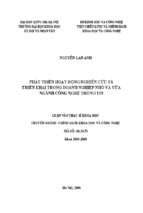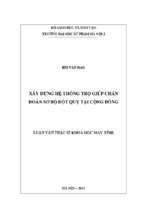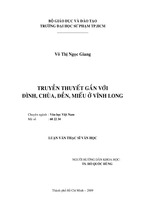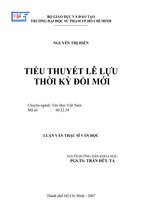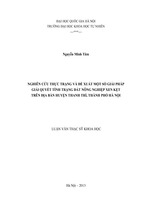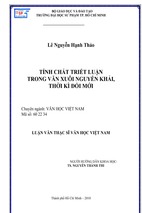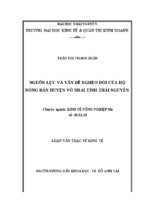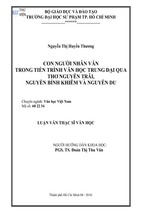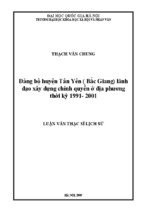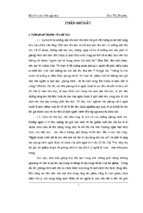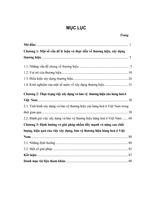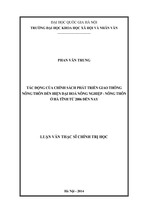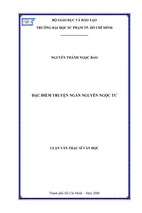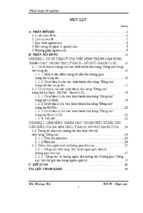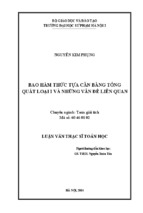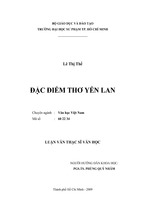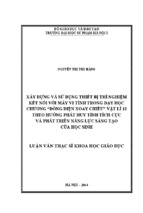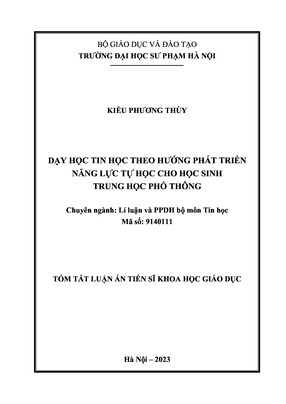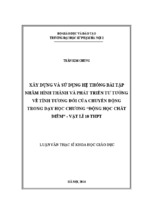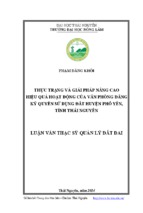VIETNAM NATIONAL UNIVERSITY, HANOI
UNIVERSITY OF LANGUAGES AND INTERNATIONAL STUDIES
FACULTY OF POST-GRADUATE STUDIES
------------------------------------
NGUYEN THI THANH TAM
A CONTRASTIVE ANALYSIS
OF ENGLISH AND VIETNAMESE PUNS
IN NEWSPAPER HEADLINES
(ĐỐI CHIẾU CHƠI CHỮ TIẾNG ANH VÀ TIẾNG VIỆT
TRONG TIÊU ĐỀ BÁO CHÍ)
M.A. MINOR THESIS
Field: English Linguistics
Code: 60220201
Hanoi – 2017
VIETNAM NATIONAL UNIVERSITY, HANOI UNIVERSITY OF
LANGUAGES AND INTERNATIONAL STUDIES
FACULTY OF POST-GRADUATE STUDIES
------------------------------------------
NGUYEN THI THANH TAM
A CONTRASTIVE ANALYSIS
OF ENGLISH AND VIETNAMESE PUNS
IN NEWSPAPER HEADLINES
(ĐỐI CHIẾU CHƠI CHỮ TIẾNG ANH VÀ TIẾNG VIỆT
TRONG TIÊU ĐỀ BÁO CHÍ)
M.A. MINOR THESIS
Field: English Linguistics
Code: 60220201
Supervisor: Assoc. Prof. Dr. Lam Quang Dong
Hanoi – 2017
DECLARATION OF AUTHORSHIP
I, Nguyen Thi Thanh Tam, declare that this thesis and the work presented in it
are my own and has been generated by me as the result of my own original
research.
A Contrastive Analysis Of English And Vietnamese Puns In Newspaper
Headlines
I confirm that:
1. This work was done wholly or mainly while in candidature for a research
degree at this University;
2. Where any part of this thesis has previously been submitted for a degree
or any other qualification at this University or any other institution, this has
been clearly stated;
3. Where I have consulted the published work of others, this is always
clearly attributed;
4. Where I have quoted from the work of others, the source is always given.
With the exception of such quotations, this thesis is entirely my own work;
5. I have acknowledged all main sources of help;
6. Where the thesis is based on work done by myself jointly with others, I
have made clear exactly what was done by others and what I have contributed
myself.
Signed: ……………………………………………………………
Date: ………………………………………………………………
i
ACKNOWLEDGMENTS
This research paper would not have been completed without the help of
people to whom I would like to express my deep gratitude.
First and foremost, I would like to express my deepest gratitude to
Associate Professor Doctor Lam Quang Dong, my supervisor, for his support,
continuous motivation and precious guidance which were decisive factors to
the completion of the thesis.
Also, I would like to extend my special thanks to my teachers, my
friends and my parents for their encouragement and support that help me
overcome difficulties to complete this study.
ii
ABSTRACT
This paper presents a contrastive analysis of English and Vietnamese
puns in newspaper headlines. The study applies the framework of Delabatista
(1996) and Yuan Chuandao (2005) to categorize puns. 200 puns are collected
randomly from 51 English newspapers and 31 Vietnamese newspapers in a
bid to ensure the objectivity of the study. Then, these puns are analyzed and
compared. The results of the research show that English and Vietnamese
share the same communicative purpose and variety in the methods to create
puns in newspaper headlines. As for differences, English newspaper headlines
tend to use puns based on the similarity of sounds, including homophonic,
homonymic, paronymic puns while Vietnamese ones are inclined to meaning
transference-based and idiom-based puns. The significant impacts of using
puns in newspaper headlines make articles become more eye-catching and
easy to draw reader‟s attention.
Keywords: puns, newspaper headlines
iii
TABLE OF CONTENTS
DECLARATION OF AUTHORSHIP ............................................................... i
ACKNOWLEDGMENTS................................................................................. ii
ABSTRACT ..................................................................................................... iii
TABLE OF CONTENTS ................................................................................. iv
LIST OF TABLES ........................................................................................... vi
PART I: INTRODUCTION .............................................................................. 1
1. Rationale ................................................................................................... 1
2. Aims of the study ...................................................................................... 2
3. Research questions .................................................................................... 2
4. Scope of the study ..................................................................................... 3
5. Methods of the study ................................................................................. 3
6. Structure of the thesis ................................................................................ 3
PART II: DEVELOPMENT ............................................................................. 4
CHAPTER 1: LITERATURE REVIEW .......................................................... 4
1.1. Related studies ........................................................................................ 4
1.2. Definitions of newspaper headline and its functions .............................. 5
1.3. Definitions of puns .................................................................................. 6
1.4. Pun and wordplay.................................................................................... 7
1.5. Pun and ambiguity .................................................................................. 8
1.6. Classifications of puns ............................................................................ 9
1.6.1 Homonymic Puns ............................................................................ 11
1.6.2 Homophonic Puns ........................................................................... 11
1.6.3 Paronymic puns ............................................................................... 12
1.6.4 Meaning transference-based puns ................................................... 13
1.6.5 Idiom-based puns ............................................................................ 14
iv
1.7. An overview on Contrastive Analysis .................................................. 16
1.8. Summary ............................................................................................... 18
CHAPTER 2: METHODOLOGY .................................................................. 19
2.1. The data ................................................................................................. 19
2.1.1. English newspapers ......................................................................... 19
2.1.2. Vietnamese newspapers .................................................................. 19
2.2. Procedures ............................................................................................. 20
CHAPTER 3: FINDINGS AND DISCUSSION ............................................ 21
3.1. English and Vietnamese headlines using homonymic puns ................. 21
3.2. English and Vietnamese headlines using homophonic puns ................ 23
3.3. English and Vietnamese headlines using paronymic puns .................. 25
3.4. English and Vietnamese headlines using meaning transference- based
puns... ........................................................................................................... 27
3.5. English and Vietnamese headlines using idiom-based puns ................ 29
3.6. Similarities and differences between English and Vietnamese puns in
newspaper headlines .................................................................................... 31
3.6.1. Similarities ...................................................................................... 32
3.6.2. Differences ...................................................................................... 33
3.7. Summary ............................................................................................... 35
PART III: CONCLUSION .............................................................................. 36
1. Recapitulation ......................................................................................... 36
2. Limitations of the study .......................................................................... 37
3. Implications ............................................................................................. 37
4. Suggestions for further studies................................................................ 37
REFERENCES ................................................................................................ 38
APPENDIX ........................................................................................................ I
v
LIST OF TABLES
Table 1: The number of English and Vietnamese puns in
newspaper headlines in terms of punning methods
vi
31
PART I: INTRODUCTION
1. Rationale
For centuries, the press has always played an important role in
transmitting information to the wide public, and in that way, it exerts
considerable influence on the public, governments, and almost all other social
entities. Therefore, journalists always find ways to improve their articles. The
headline of a newspaper can be seen as the most important part of an article.
In other words, it is a crucial part that attracts readers. The headline is always
the first thing that readers pay attention to when they want to read or buy a
newspaper. It serves as a guide for readers to decide whether to continue
reading the whole article or move to another one. Therefore, a headline needs
to be titled carefully and creatively. The more eye-catching and impressive a
headline is, the more readers the newspaper attracts.
There is no surprise that many newspapers are saturated with strategies
to draw readers‟ attention. Among those strategies is the use of puns.
Although they may share certain similarities, puns tend to be unique forms
and specific to each language. Puns are also special forms of humor based on
semantic ambiguity, polysemy, homophony, amongst others. Speakers and
writers use the similarities of sounds and meanings to create surprises in the
listeners and readers‟ interpretation.
Understanding puns is part of the process of language acquisition, so
puns are part of charm that belongs to any language. Learning to understand
puns in a new language is both a cause and a consequence of language
proficiency.
However, even native speakers need to utilize a great deal of linguistic
information and background knowledge to understand a pun. Without
1
adequate background knowledge and cultural understanding, readers or
listeners are likely to encounter difficulty understanding puns in another
language. Likewise, Vietnamese learners who study English encounter many
difficulties in comprehending puns, especially English puns in newspaper
headlines. Obviously, it is not simply the matter of vocabulary. It is language
and cultural understanding. The unique characteristics of puns pose a great
challenge to Vietnamese learners of English when they begin to read English
newspapers.
This is the reason why I decided to conduct the research “A contrastive
analysis of English and Vietnamese puns in newspaper headlines”. My
expectation is that this research will help Vietnamese learners of English
comprehend the use of puns and distinguish the similarities and differences
between English and Vietnamese puns in newspaper headlines.
2. Aims of the study
In light of Contrastive Analysis, the study attempts to help readers and
learners gain better knowledge about puns in general and puns in English and
Vietnamese in particular. In addition, from this research, readers or learners
can have some reference to make their own interpretation of puns in English
or Vietnamese newspaper headlines which they encounter in real life.
3. Research questions
The study is an attempt to analyze and contrast puns in English and
Vietnamese newspaper headlines. Therefore, the research seeks answers to
the following questions:
- What are the similarities between puns in English newspaper
headlines and their counterpart in Vietnamese in terms of punning method?
- What are the differences between puns in English newspaper
headlines and their counterpart in Vietnamese in terms of punning method?
2
4. Scope of the study
Like all other linguistic phenomena, puns can be examined in different
aspects. Moreover, as a verbal product of human intelligence, it is very
abundant and diverse. So, surely there will be innumerable issues about
punning to be discussed. However, within the framework of an M.A. thesis,
the study cannot cover all aspects of puns but limits to some major linguistic
features and types of English and Vietnamese puns in newspaper headlines.
5. Methods of the study
The study is conducted as an attempt to understand more about the
nature of puns which are used in English and Vietnamese newspaper
headlines. Given this nature of the study, comparative and contrastive
methods will be used as the principal methods. Besides, descriptive and
analytical methods are also used to clarify data in the study.
6. Structure of the thesis
The thesis is structured in three parts:
In part I, the reasons for choosing the topic, the aims, the research
questions, the research methods, the scope and the structure of the thesis are
introduced. Part II, which is the main part of the thesis, consists of three
chapters.
Chapter 1 is the Literature Review. The methodology used in the study
is presented in the second chapter. It includes a description of data collection
and data analysis procedures used in the study. The findings of the study are
presented in the third chapter.
Part III provides the conclusion of the study, its limitations as well as
suggestions for further research.
3
PART II: DEVELOPMENT
CHAPTER 1: LITERATURE REVIEW
1.1.
Related studies
Puns have been a subject of studies by a lot of linguists in English as
well as Vietnamese at different levels.
Ling, X. (2006) views puns from the angle of language function to
analyze typical functions of puns in English advertisements. He founds that
the most distinctive functions in English advertisements are aesthetic function
and vocative function. Vocative function of puns refers to the language
function that the readers may take actions to do as the text expects. Aesthetic
function refers to the language function that can create a sense of beauty
among readers.
Stelter, J. (2011) in her study investigate hypotheses related to puns in
English and German based on a bilingual corpus of 2400 jokes from
published collections. From testing these hypotheses, she points out
distinctive features of puns in English and German. While the former inclines
puns that use linguistic phenomena and devices such as homophony,
phrasemic ambiguity and syntactic ambiguity, the later depends on systemic
ambiguities.
For the pedagogical purpose, Lems, K. (2013) pays much attention to the
way of teaching English using puns in class. With her fresh view, teaching
and studying seem to be more interesting. She believes that if students in a
class can laugh together, they likely to learn better together, too.
Giorgadze, M. (2014) investigates deeply the linguistics features of pun
and its classification. From his study, the new classification is set up with
4
three types of puns: lexical-semantic puns, structural-syntactic puns and
structural-semantics puns.
Monsefi, R., & Mahadi, T. S. T. (2016) are interested in wordplay in
English Online New Headlines. They find that the most frequent wordplay in
these headlines is that of tropes or more specifically metonymy.
In Vietnamese, Lê Trung Hoa and Hồ Lê (2013) point out types of puns
in Vietnamese with clearly explained examples. Their work demonstrates the
variety and diversity of puns in Vietnamese as well as the creativity of
Vietnamese people in using puns.
Trần Thị Thu Hiền (2011) conducts a study to examine word-playing
methods used by manufacturers in their advertisements in English and
Vietnamese.
Despite their extensive use in many languages, up to now a contrastive
analysis of English and Vietnamese puns in newspaper headlines has not been
taken into consideration in any studies. For this reason, the thesis is carried
out to investigate in-depth on this issue.
1.2. Definitions of newspaper headline and its functions
In “The Language of Newspaper” (2002: 13), Reah stated that a
newspaper headline is “a unique type of text that consists of a range of
functions that specifically dictate its shape, content, and structure, and it
operates within a range of restrictions that limit the freedom of the writer”.
According to Ungerer (2000:48), “a headline describes the essence of a
complicated news story in a few words. It informs quickly and accurately and
arouses the reader’s curiosity”. In “Oxford Learner’s Pocket Dictionary
Third Edition”, headline is defined as “the title of a newspaper article printed
in large letters, especially at the top of the front page”. In short, a headline is
5
the title of an article. It is a condensed form of writing and enables readers to
know the whole content of the news in a few words.
According to Conboy (2007), headlines serve three important functions.
First, they provide a brief summary of the main news to the reader; hence,
readers do not have to read the whole story to capture the point. Secondly,
newspaper headlines attract attention. Headlines draw people‟s attention by
various font sizes and vocabulary used. Finally, they often provide an initial
indicator of the content and style of the news value of the newspaper. This is
an important way for newspapers to appeal to the audience.
1.3. Definitions of puns
Puns are a figure of speech commonly used in all languages. The
English punning tradition goes back a long time and the greatest punsters
include William Shakespeare, Oscar Wilde and Lewis Carroll. Now, puns are
still frequently used in English speaking countries in many genres such as
riddles, jokes, humorous quotations, advertising slogans and newspaper
headlines. In Vietnam, punning has existed for a long time from old folk
songs to modern written literature. It actually enriches Vietnamese literature
and culture by exploiting the potentials of language.
Puns are defined in various ways. In “Longman Dictionary of
American English” (2008: 825), pun is considered “an amusing use of a word
or phrase that has two meanings or of words with the same sound at different
meanings”.
Keith Brown and Jim Miller (2013: 366) claim that pun is “a play on
words for humorous effect”.
Wales (2001: 326) emphasizes that a pun is an ambiguity; specifically,
6
a foreground lexical ambiguity. It involves the use of a polysemous word to
suggest two or more meanings; or the use of homonyms, i.e. different words
which look or sound the same but having different meanings. The whole point
of a pun, however, is the user‟s intent to produce a humorous or witty effect
from the juxtaposition of meanings. Thus puns commonly occur in jokes.
Delabastita (1996:128) implies pun as “the general name for the
various textual phenomena in which structural features of the language(s)
used are exploited in order to bring about a communicatively significant
confrontation of two (or more) linguistic structures with more or less similar
forms or more or less different meaning”.
Hoàng Phê and other Vietnamese scholars (2003: 172) assert that pun
is the use of homophones, polysemy and so on in a language to create a
specific effect in an utterance such as humor, criticism and others.
From the above definitions, it can be concluded that pun is a figure of
speech which intentionally uses some phenomena of a language based on
meanings, sounds or structures to make an utterance produce at least two
different readings. Humorous or any other effects are created by puns depend
on the ambiguities words entail.
1.4.
Pun and wordplay
There is no consensus among scholars on the difference between
wordplay and a pun. Some scholars underline these two terminologies mostly
interchangeable and synonymous terms (Delabastia, 1996). By contrast,
Giorgadze, M. (2014) claims that pun is one of the types of wordplay,
whereas wordplay is classed as an umbrella term denoting all the subclasses.
I do totally agree with Giorgadze‟s point of views. In my opinion, the relation
between wordplay and pun is hierarchy in which pun is a subtype of
7
wordplay. Wordplay is made up of pun, spoonerism, anagram, palindrome,
onomatopoeia, mondegreen, malapropism, oxymoron, etc.
1.5. Pun and ambiguity
Ambiguity relates to the language user‟s limited knowledge of syntax
and lexicology and it often causes a great deal of confusion to the listeners or
readers. Take the sentence below as an example.
E.g.: Where do fish learn to swim?
They learn from a school. (Carol, Alice‟s Adventures in Wonderland)
From the mentioned example, the listeners and readers may be
confused about where the fish actually learn to swim. They learn from a place
where children go to be educated or they learn to swim together with a group
of fish. Without a context for clarification, the example can be ambiguous,
although the latter reading would be the natural one. Such communicationhindering expressions should be completely avoided. However, besides this
unintentional kind of ambiguity is the deliberate one which is intentionally
used and bring high rhetorical effects. The extreme form of this ambiguity is
pun. Humor is considered the most significant feature that puns create. In
puns, ambiguity is comprehensively exploited and becomes one of the crucial
modes of creating jokes.
There are two categories of ambiguity, lexical and structural. Lexical
ambiguity is any ambiguity that results from the different meanings of a
certain word. The polysemous word “school” in the previous example is
lexically ambiguous because it raises two separate readings. Meanwhile,
structural ambiguity arises when a complex phrase or a sentence can be
parsed in more than one way. In other words, a phrase or a sentence is
8
structurally ambiguous when it has more than one underlying structure.
Sometimes both semantic and syntactic (or structural) ambiguities co-occur,
with semantic ambiguity leading to syntactic one or vice versa.
E.g.:
Waiter, will my pizza be long?
No sir, it will be round!
In this case, the question “Will my pizza be long?” can be interpreted in
two ways due to the multiple meanings of the word long as well as the
sentence structure:
(1) Will I have to wait long for my pizza?
(2) Is the shape of my pizza long?
Actually, the guest refers to how long he/she has to wait, but the
answer is totally humorous. The waiter here skillfully exploited both semantic
and syntactic ambiguity in his reply.
1.6. Classifications of puns
As perceptions of puns are different, there are various approaches to
classify puns.
Lems, K. (2013) divides puns into four major categories:
Soundalike puns (two or more words that sound the same but have
different spellings and meanings)
Lookalike puns (sound and look the same but have two or more unrelated
meanings)
Close-sounding puns (different meanings and spellings but sound
similar, differing in only one or two sounds)
Texting puns (the sounds and/or spelling of alphabet letters, numbers of
9
symbols, or simplified spelling as a way to represent or “spell” a word. For
example, “cre8” is for “create”.)
Yuan Chuandao (2005) claims that the creation of pun is connected not
only to the meaning and the homophony of a word, but also to the context,
manner of speech and logic. Therefore, he figures out the following types of
pun:
Homonymic pun (identical sounds and spelling)
Lexical meaning pun (polysemous words)
Understanding pun (through the particular context, implied meaning of a
sentences is revealed)
Figurative pun (a simile or a metaphor as its surface meaning and the
figurative meaning as its deep meaning)
Logic pun (a rhetorical device, a kind of implication in a particular
context)
Delabastita (1996:128) divided puns into four main categories based on
the level of similarity concerning sounds and spelling:
Homonymy (identical sounds and spelling)
Homophony (identical sounds but different spellings)
Homography (different sounds but identical spellings)
Paronymy (there are slight differences in both spelling and sound)
As research reveals, a pun is one of the most important types of
wordplay. There are several subcategories of pun and consequently its various
classifications and types are formulated by different scholars. However, each
framework has its drawbacks. On the basis of the mentioned various
classifications of puns and the analysis of the examples in the research, a new
classification form of pun including the five most typical types of puns based
10
on punning methods will be in focus. They consist of homonymic,
homophonic, paronymic, meaning transference based and idiom-based puns.
1.6.1 Homonymic Puns
This type of pun is a highly productive eye-catching device based on
exploitation of words which are identical in both spelling and sounds.
However, these words have unrelated meanings.
For example, “Panda can’t bear pal’s beastly behavior”, the headline in “The
Sun” on November 2, 2011, uses homonymic puns. The word “bear” has two
meanings, one is a kind of animal and the other is to have tolerance.
Another example of homonymic in Vietnamese can be taken from its
traditional folk verses.
“Bà già đi chợ Cầu Đông
Bói xem một quẻ lấy chồng lợi chăng
Thầy bói gieo quẻ nói rằng
Lợi thì có lợi nhưng răng chẳng còn.”
The word “lợi” means “benefit” and “gum”. The punster makes use of
the ambiguity of meaning in the folk verses to criticize the old woman who
wants to get married. It is not highly approvable in Vietnamese culture at that
time. The fortune-teller says that getting married is acceptable but her gums
and teeth show that her age and health are no longer suitable for marriage, or
she is too old to get married.
1.6.2 Homophonic Puns
A homophonic pun is the common type of puns which exploits distinct
meanings or spelling of the same spoken words. Its central feature is
phonemic ambiguity. Understanding how they work helps learners with both
11
phonological awareness and, later, reading and spelling.
E.g. 1:
A: There is an overweight lady in our town. She's wearing a dress size 16. I
knew her when she was young, but she wore a much smaller size then.
B: Why do you know she is wearing size 16? A: I guess she just 8 + 8 (ate and
ate).
E.g. 2: On Sunday they pray for you and on Monday they prey on you.
The pun is based on the similarity in pronunciation of the word “eight”
and “ate” in example 1. In the other example, “pray” and “prey” are
pronounced the same, but the meanings are entirely different. “Pray” means
speak to God, especially to give thanks or ask for help while “prey” means
plunder.
Another example of homophonic pun which seems easy to recognize and
understand for beginners is “A peace of cake”. In this case, punster exploits
the same sounds between “peace” and “piece” in order to create a witty
utterance.
1.6.3 Paronymic puns
Paronymic puns are based on words that have different meanings and
spellings but their sounds are nearly similar. For example, “How do turtles
talk to each other? By using shell phones!”. In this example, “shell phones” is
quite similar to “cell phones” in terms of the sounds. There is a little
difference between the consonants of /ʃ/ and /s/.
These examples below demonstrate the humorous use of patronymic puns.
E.g. 1: The barber went to the bank and opened a shaving account.
12
- Xem thêm -


